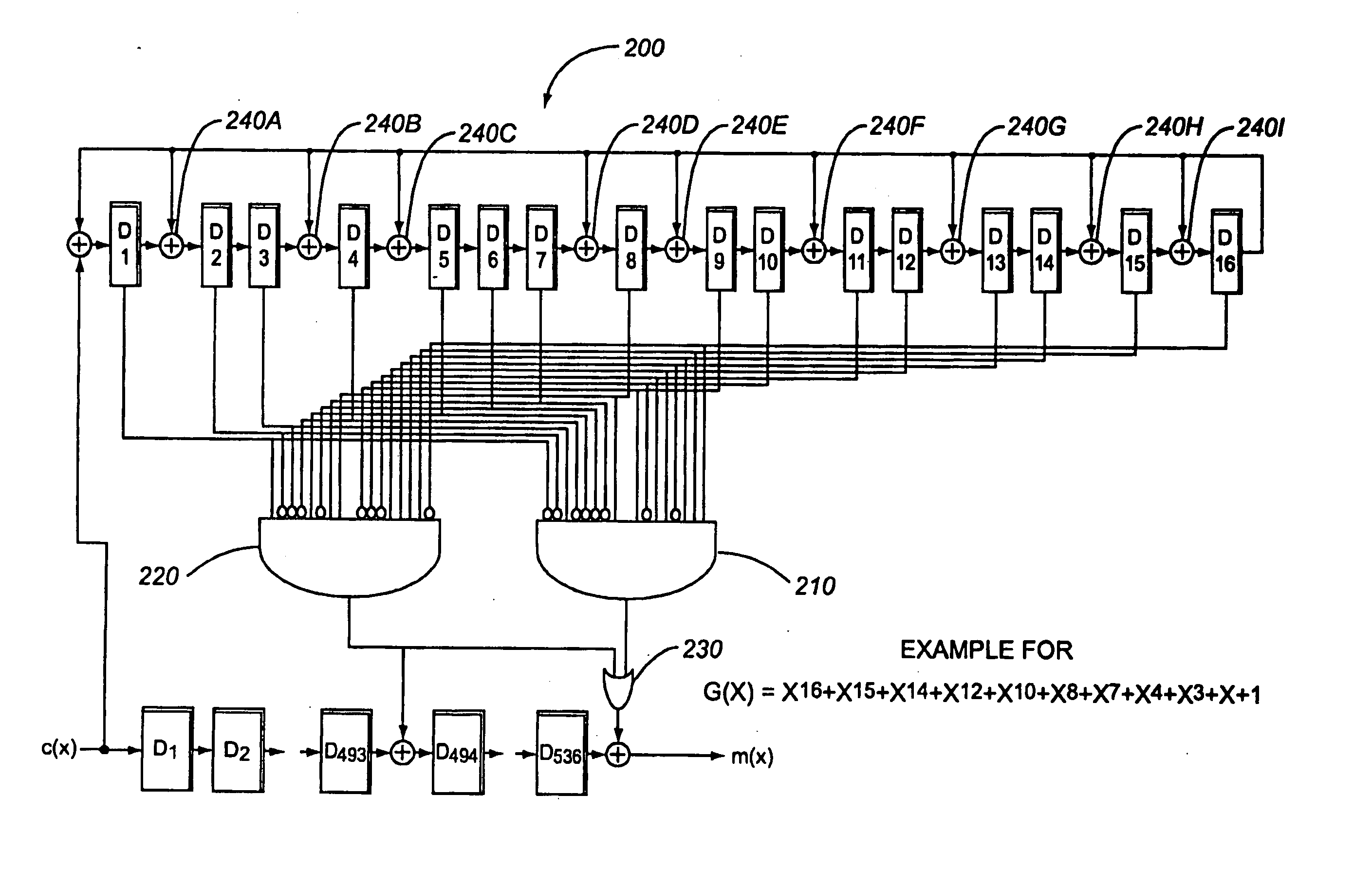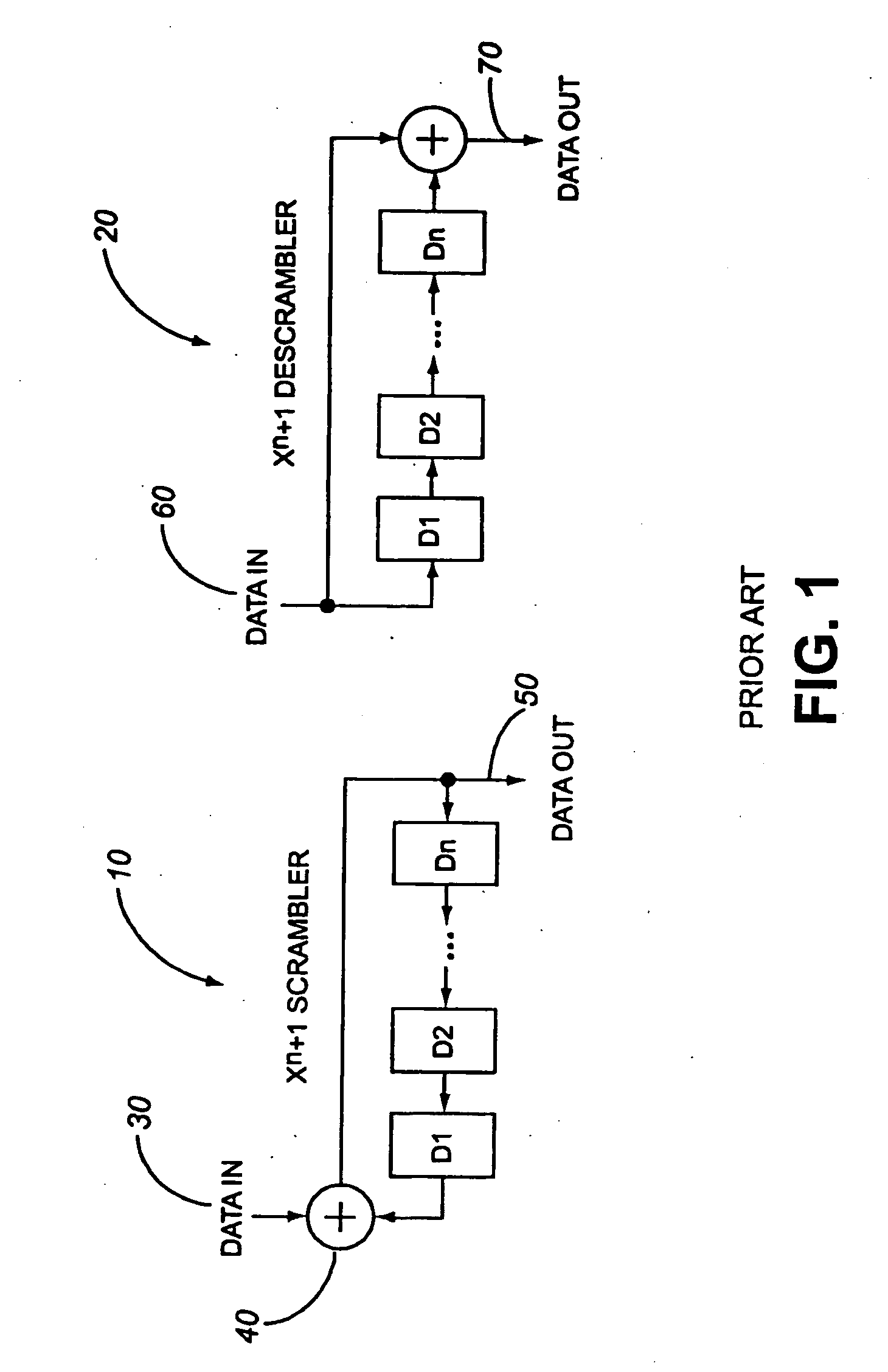Cyclic redundancy check circuit for use with self-synchronous scramblers
a cyclic redundancy check and self-synchronous scrambler technology, applied in the direction of coding, instruments, code conversion, etc., can solve the problems of receiver failure, possible for a malicious subscriber, and much more difficult for a malicious user to defeat the effect of frame synchronous scrambler
- Summary
- Abstract
- Description
- Claims
- Application Information
AI Technical Summary
Problems solved by technology
Method used
Image
Examples
first embodiment
[0041]FIG. 3 illustrates a circuit 200 for detecting and correcting single and double bit errors according to the present invention. The first embodiment is intended for an initial proposed transparent GFP superblock CRC-16. The circuit 200 consists of a plurality of bit circuit elements D1, D2, D3, D4, D5, D6, D7, D8, D9, D10, D11, D12, D13, D14, D15, D16, two logic AND gates 210, 220, an OR gate 230, and a plurality of input bit stream circuit elements D1, D2, . . . , D493, D494, . . . , D536, as shown in FIG. 3. The bit circuit elements may be implemented as bit registers, or other circuit elements such as flip-flops or transistors. The CRC polynomial implemented in the circuit 200 is G(x)=x16+x15+x14+x12+x10+x8+x7+X4+x3+x+1.
[0042] According to the circuit 200 of FIG. 3, the input stream is a GFP superblock, essentially a 536 bit block, which is input into circuit elements D1 through D536. On a bit-by-bit basis, the D1 through D16 bit circuit elements receive input from the input...
second embodiment
[1046]FIG. 4 illustrates a circuit 300 for detecting and correcting single and double bit errors according to the present invention. The second embodiment is intended for a final version transparent GFP superblock CRC-16. The circuit 300 differs from that of FIG. 3, in that bitwise operations are dictated by a different G(x) polynomial. The CRC polynomial implemented in this circuit 300 is G(x)=x16+x15+x14+x12+x10+x4+X3+x2+X+1.
[1047] It should be mentioned that while the circuits of FIGS. 3 and 4 detect double bit errors generated by a descrambler, the circuits of the present invention detect single bit, double bit, and triple bit errors derived from any number of other sources. The 536 bit block need not be derived from a descrambler, such as is used on a GFP CRC-16. The circuit of the present invention may derive a 536-bit superblock, prior to processing by the circuit of the present invention. Furthermore, the art that the present invention may be embodied in other circuitry. For...
third embodiment
[1048]FIG. 5 is a block diagram of a circuit 400 for an 8-bit wide parallel implementation according to the present invention. As compared to the serial bit implementation of FIGS. 3 and 4, the error detection logic 410 outputs an 8-bit wide output to the OR gate 420. In an 8-bit wide parallel implementation, errors are detected for an 8-bit wide block. The single and double errors are corrected in the same manner as in the implementation of FIG. 4 with the advantage that operating on 8-bit data blocks allows the circuit to operate at ⅛ the data path clock speed of a serial implementation such as in FIGS. 3 and 4. The data path clock speed reduction is a significant advantage for high-speed data transmission.
[1049] In FIG. 5, the process implemented by the circuit 400 is similar to that of FIGS. 3 and 4. The parallel CRC-16 generator consists of a bit circuit elements which are coupled to sequentially receive and store a sequential 16 bits derived from an 8-bit wide input stream 450...
PUM
 Login to View More
Login to View More Abstract
Description
Claims
Application Information
 Login to View More
Login to View More - R&D
- Intellectual Property
- Life Sciences
- Materials
- Tech Scout
- Unparalleled Data Quality
- Higher Quality Content
- 60% Fewer Hallucinations
Browse by: Latest US Patents, China's latest patents, Technical Efficacy Thesaurus, Application Domain, Technology Topic, Popular Technical Reports.
© 2025 PatSnap. All rights reserved.Legal|Privacy policy|Modern Slavery Act Transparency Statement|Sitemap|About US| Contact US: help@patsnap.com



